The Neglected Tropical Disease Treatment Market is estimated to be valued at USD 3.9 billion in 2025 and is projected to reach USD 5.9 billion by 2035, registering a compound annual growth rate (CAGR) of 4.3% over the forecast period.
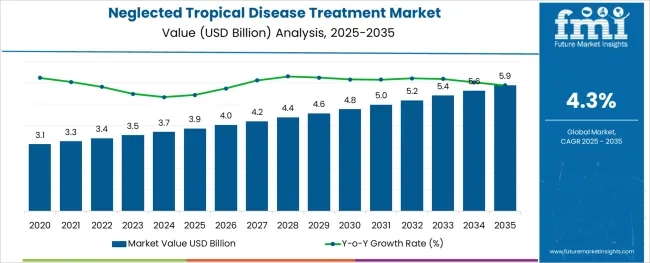
The neglected tropical disease treatment market is experiencing growth driven by the global focus on controlling and eliminating diseases prevalent in underserved populations. Increased attention from public health initiatives and international organizations has pushed for improved access to treatments targeting parasitic infections. The rise in funding for neglected diseases has accelerated the development and distribution of effective therapies.
Advances in drug formulations and delivery systems have improved treatment adherence and patient outcomes. Moreover, healthcare infrastructure improvements in endemic regions have enhanced the availability of diagnostics and medications.
As efforts to address disease burden intensify, market growth is expected to continue. Key segment drivers include the anti-parasite drug class, leishmaniasis as a major disease focus, and direct sales channels that enable efficient delivery to remote areas.
The market is segmented by Drug Class, Disease Type, and Distribution Channel and region. By Drug Class, the market is divided into Anti-Parasite, Antifungal, Antibiotics, and Others. In terms of Disease Type, the market is classified into Leishmaniasis, Schistosomiasis, Lymphatic Filariasis, Chagas Disease, African Trypanosomiasis, and Others.
Based on Distribution Channel, the market is segmented into Direct Sales and Indirect Sales. Regionally, the market is classified into North America, Latin America, Western Europe, Eastern Europe, Balkan & Baltic Countries, Russia & Belarus, Central Asia, East Asia, South Asia & Pacific, and the Middle East & Africa.
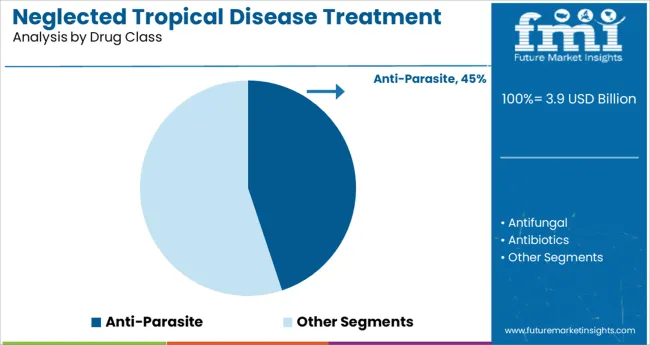
The anti-parasite drug class segment is projected to hold 44.9% of the neglected tropical disease treatment market revenue in 2025, leading the drug category. Growth in this segment has been supported by the widespread prevalence of parasitic infections such as leishmaniasis, schistosomiasis, and onchocerciasis in tropical regions. These drugs have been essential in controlling parasite life cycles and reducing disease transmission.
Advances in formulation have improved drug efficacy and safety profiles, encouraging wider use in treatment programs. Public health campaigns and mass drug administration initiatives have also increased demand for anti-parasitic agents.
Given the continued burden of parasitic diseases in many low-income areas, this drug class is expected to maintain its market dominance.
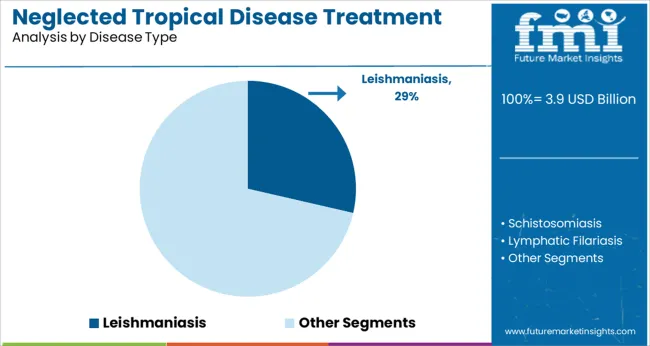
The leishmaniasis segment is anticipated to contribute 28.6% of the market revenue in 2025, positioning it as a key disease focus. This growth is driven by the disease’s significant prevalence across tropical and subtropical regions and its severe health impact if left untreated.
The segment has benefited from increased disease surveillance and improved diagnostic methods that enable timely treatment. Efforts to develop new therapeutics with better safety and shorter treatment durations have also supported segment growth.
Healthcare providers in endemic areas have prioritized leishmaniasis management to reduce morbidity and mortality. As global health programs intensify their efforts to combat this disease, the leishmaniasis segment is expected to remain critical in neglected tropical disease treatment.
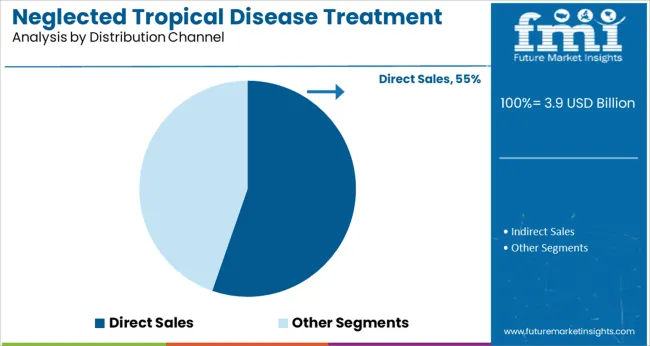
The direct sales distribution channel segment is projected to hold 55.3% of the neglected tropical disease treatment market revenue in 2025, maintaining its leading role in product delivery. Growth in this channel has been driven by the necessity of reaching remote and underserved populations where traditional distribution networks are limited.
Direct sales models allow manufacturers and health organizations to supply medications efficiently to healthcare facilities, clinics, and outreach programs. This approach helps ensure timely delivery and reduces supply chain bottlenecks.
Additionally, direct engagement with governments and NGOs has facilitated bulk procurement and streamlined distribution in endemic regions. As access to neglected tropical disease treatments continues to be a priority, direct sales channels are expected to remain the preferred method for reaching affected communities.
The rising prevalence of neglected tropical diseases in emerging countries owing to multiple factors, such as the absence of proper hygiene maintenance and shortage of basic services including clean water is estimated to boost the global neglected tropical disease treatment market growth.
The increasing usage of antiparasitic drugs, antiviral drugs, and antibacterial drugs for the treatment of Chagas disease, African sleeping sickness, Buruli ulcer, and leishmaniasis is another vital factor that is projected to drive the market.
Government bodies of various countries are consistently creating awareness among people regarding the availability of medicines for the treatment of these diseases. They are aiming to encourage people to practice better health practices in their everyday lives. Numerous companies across the globe are consistently investing huge sums in research and development activities to create new treatment options.
As neglected tropical diseases occur in poor parts of countries, the lack of awareness among people may decline sales of neglected tropical disease treatment options. The lack of access to cutting-edge medications and the presence of an underdeveloped healthcare infrastructure in these countries are a couple of other factors that may obstruct the growth in this market.
Asia Pacific is expected to remain at the forefront in future years by generating the largest neglected tropical disease treatment market share. This growth is attributable to the presence of a huge target population and the rising GDP rate in India and China.
The increasing prevalence of neglected tropical diseases, such as trichuriasis, rabies, hookworm infection, visceral leishmaniasis, dengue fever, and ascariasis in these developing countries is another significant factor that is projected to bode well for the regional market.
The Indian government, for instance, has collaborated with the World Health Organization (WHO) to make financial investments in healthcare to eliminate and reduce cases of such diseases.
The increasing untapped potential for the treatment of patients suffering from neglected tropical diseases in Brazil and Mexico is anticipated to augur well for the Latin America market. The rising number of awareness programs conducted by governments of these countries is also set to push the demand for neglected tropical disease treatment options in Latin America.
As per a study published in the National Library of Medicine, nearly 40% of the projected 556 million people living in the Caribbean and Latin American region are below the poverty line. It includes 74 million people who live on less than USD 2 per day and 47 million people that live on less than USD 1 per day. These numbers are expected to grow at a rapid pace in the forthcoming years, thereby propelling the regional market.
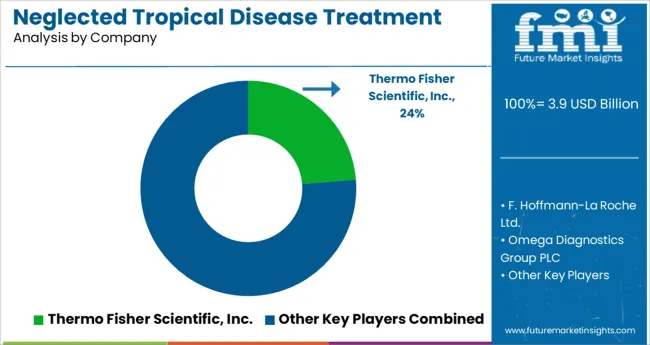
Some of the leading companies present in the global neglected tropical disease treatment market include Thermo Fisher Scientific, Inc., F. Hoffmann-La Roche Ltd., Omega Diagnostics Group PLC, Abbott, Oscar Medicare Pvt Ltd., Genome Diagnostics Pvt. Ltd., and ZeptoMetrix among others.
Majority of the key players operating in the global market are increasingly focusing on partnerships, collaborations, and new product development to strengthen their positions. Meanwhile, a few other companies are aiming to gain fast track approvals from regulatory bodies, such as the USA FDA to distribute and market their products.
| Report Attribute | Details |
|---|---|
| Growth Rate | CAGR of 4.3% from 2025 to 2035 |
| Base Year for Estimation | 2024 |
| Historical Data | 2020 to 2024 |
| Forecast Period | 2025 to 2035 |
| Quantitative Units | Revenue in billion, Volume in Kilotons and CAGR from 2025 to 2035 |
| Report Coverage | Revenue Forecast, Volume Forecast, Company Ranking, Competitive Landscape, Growth Factors, Trends and Pricing Analysis |
| Segments Covered | Drug Class, Disease Type, Distribution Channel, Region |
| Regions Covered | North America; Latin America; Western Europe; Eastern Europe; APEJ; Japan; Middle East and Africa |
| Key Countries Profiled | USA, Canada, Brazil, Argentina, Germany, UK, France, Spain, Italy, Nordics, BENELUX, Australia & New Zealand, China, India, ASEAN, GCC, South Africa |
| Key Companies Profiled | Thermo Fisher Scientific, Inc.; F. Hoffmann-La Roche Ltd.; Omega Diagnostics Group PLC; Abbott; Oscar Medicare Pvt Ltd.; Genome Diagnostics Pvt. Ltd.; ZeptoMetrix |
| Customization | Available Upon Request |
The global neglected tropical disease treatment market is estimated to be valued at USD 3.9 billion in 2025.
It is projected to reach USD 5.9 billion by 2035.
The market is expected to grow at a 4.3% CAGR between 2025 and 2035.
The key product types are anti-parasite, antifungal, antibiotics and others.
leishmaniasis segment is expected to dominate with a 28.6% industry share in 2025.






Full Research Suite comprises of:
Market outlook & trends analysis
Interviews & case studies
Strategic recommendations
Vendor profiles & capabilities analysis
5-year forecasts
8 regions and 60+ country-level data splits
Market segment data splits
12 months of continuous data updates
DELIVERED AS:
PDF EXCEL ONLINE
Tropical Fruit Enzymes Market Size and Share Forecast Outlook 2025 to 2035
Treatment-Resistant Hypertension Management Market Size and Share Forecast Outlook 2025 to 2035
Treatment-Resistant Depression Treatment Market Size and Share Forecast Outlook 2025 to 2035
Treatment Pumps Market Insights Growth & Demand Forecast 2025 to 2035
Pretreatment Coatings Market Size and Share Forecast Outlook 2025 to 2035
Air Treatment Ozone Generator Market Size and Share Forecast Outlook 2025 to 2035
CNS Treatment and Therapy Market Insights - Trends & Growth Forecast 2025 to 2035
Seed Treatment Materials Market Size and Share Forecast Outlook 2025 to 2035
Acne Treatment Solutions Market Size and Share Forecast Outlook 2025 to 2035
Scar Treatment Market Overview - Growth & Demand Forecast 2025 to 2035
Soil Treatment Chemicals Market
Water Treatment System Market Size and Share Forecast Outlook 2025 to 2035
Water Treatment Chemical Market Size and Share Forecast Outlook 2025 to 2035
Algae Treatment Chemical Market Forecast and Outlook 2025 to 2035
Water Treatment Market Size and Share Forecast Outlook 2025 to 2035
Water Treatment Ozone Generator Market Size and Share Forecast Outlook 2025 to 2035
Water Treatment Equipment Market Size and Share Forecast Outlook 2025 to 2035
Burns Treatment Market Overview – Growth, Demand & Forecast 2025 to 2035
CRBSI Treatment Market Insights - Growth, Trends & Forecast 2025 to 2035
Water Treatment Polymers Market Growth & Demand 2025 to 2035

Thank you!
You will receive an email from our Business Development Manager. Please be sure to check your SPAM/JUNK folder too.
Chat With
MaRIA